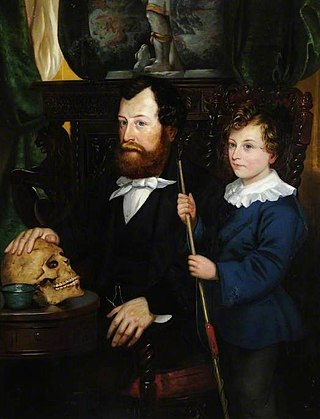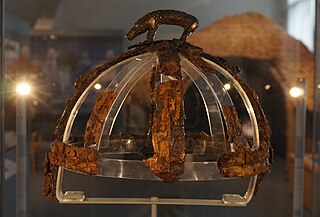
Charles Warne (1802 – 11 April 1887) was an English antiquarian and archaeologist who specialized in the prehistoric and ancient monuments of Dorset.

Charles Warne (1802 – 11 April 1887) was an English antiquarian and archaeologist who specialized in the prehistoric and ancient monuments of Dorset.
Born in Dorset, with the poet William Barnes he was involved in protecting the Maumbury Rings which resulted in their statutory protection from the route of the proposed Wilts, Somerset and Weymouth Railway Act 1845 (8 & 9 Vict. c. liii). This was the first time an antiquity was saved from being damaged by a proposed train route as a result of the actions of local protestors. [1] He became a close friend of Charles Roach Smith and in 1853 and 1854 he made archaeological tours in France with Smith and Frederick William Fairholt. [2]
Warne published accounts of his archaeological discoveries between 1836 and 1872 many of which were based on his own research and fieldwork. Elected as a Fellow of the Society of Antiquaries of London in 1856, Warne was then and for some time afterwards a resident of London. He made researches into the prehistoric remains of Dorset. Then for a long time he lived at Ewell, Surrey; the last years of his life were spent at Brighton, where he died on 11 April 1887. [2]
During his lifetime Warne amassed a large collection of English and Roman coins part of which was sold by Messrs. Sotheby, Wilkinson, & Hodge, on 24 and 25 May 1889, two years after his death. [1] [2] Warne's collection of sepulchral urns and other relics from barrows went to Dorchester Museum.
His grave in Brookwood Cemetery is designed to resemble a prehistoric barrow with the upright stone being made from serpentinite. [1]
Warne's works were: [2]
Warne also contributed "Observations on Vespasian's first Campaign in Britain" to Archæologia (xl. 387), and "Archæological Notes made during a Tour in France" to Charles Roach Smith's Retrospections (vol. ii. 1886). [2]

Thomas Bateman was an English antiquary and barrow-digger.

The Benty Grange helmet is an Anglo-Saxon boar-crested helmet from the seventh century AD. It was excavated by Thomas Bateman in 1848 from a tumulus at the Benty Grange farm in Monyash in western Derbyshire. The grave had probably been looted by the time of Bateman's excavation, but still contained other high-status objects suggestive of a richly furnished burial, such as the fragmentary remains of a hanging bowl. The helmet is displayed at Sheffield's Weston Park Museum, which purchased it from Bateman's estate in 1893.

Carl Wark is a rocky promontory on Hathersage Moor in the Peak District National Park, just inside the boundary of Sheffield, England. The promontory is faced by vertical cliffs on all but one side, which is protected by a prehistoric embankment. The cliffs and embankment form an enclosure that has been interpreted as an Iron Age hill fort, though the date of construction and purpose of the fortifications remains unknown. The site is a scheduled monument.

Charles Roach Smith, FSA, was an English antiquarian and amateur archaeologist who was elected a fellow of the Society of Antiquaries of London, and the London Numismatic Society. He was a founding member of the British Archaeological Association. Roach Smith pioneered the statistical study of Roman coin hoards.

The Cerne Abbas Giant is a hill figure near the village of Cerne Abbas, in Dorset, England. It is currently owned by the National Trust, and listed as a scheduled monument of England. Measuring 55 metres (180 ft) in length, the hill figure depicts a bald, nude male with a prominent erection, holding his left hand out to the side and wielding a large club in his right hand. Like many other hill figures, the Cerne Giant is formed by shallow trenches cut into the turf and backfilled with chalk rubble.

Albert Way was an English antiquary, and principal founder of the Royal Archaeological Institute.

Richard Saul Ferguson was an English antiquary, specialising in the local history of Cumberland and Westmorland.

Bryan Faussett was an English antiquary. Faussett formed a collection that was rich in Anglo-Saxon objects of personal adornment, such as pendants, brooches, beads and buckles. He discovered the Kingston Brooch, the largest known Anglo-Saxon composite brooch. At the time of his death he had the world's largest collection of Anglo-Saxon items.

Joseph Mayer (1803–1886) was an English goldsmith, antiquary and collector.

John Merewether was an English churchman, Dean of Hereford from 1832, known also as an antiquary.
John Romilly Allen FSA FSAScot was a British archaeologist.
John Clavell Mansel-Pleydell (1817–1902), originally John Clavell Mansel, was a Dorset antiquary, known for contributions to geology, botany, and ornithology.
Michael Waistell Taylor (1824–1892) was a Scottish physician, known also as an antiquarian.
George Alexander Hillier (1815–1866) was an English antiquarian.
Cecily Margaret Guido,, also known as Peggy Piggott, was an English archaeologist, prehistorian, and finds specialist. Her career in British archaeology spanned sixty years, and she is recognised for her field methods, her field-leading research into prehistoric settlements, burial traditions, and artefact studies, as well as her high-quality and rapid publication, contributing more than 50 articles and books to her field between the 1930s and 1990s.
Thomas Stackhouse was an English antiquary and educational writer.

The Benty Grange hanging bowl is a fragmentary Anglo-Saxon artifact from the seventh century AD. All that remains are parts of two escutcheons: bronze frames that are usually circular and elaborately decorated, and that sit along the outside of the rim or at the interior base of a hanging bowl. A third one disintegrated soon after excavation, and it no longer survives. The escutcheons were found in 1848 by the antiquary Thomas Bateman, while excavating a tumulus at the Benty Grange farm in western Derbyshire. They were presumably buried as part of an entire hanging bowl. The grave had probably been looted by the time of Bateman's excavation, but still contained high-status objects suggestive of a richly furnished burial, including the hanging bowl and the boar-crested Benty Grange helmet.
Charles Sandys (1786–1859) was an English antiquarian and member of the Sandys family. He was an early member of the British Archaeological Association and fellow of the Society of Antiquaries. He composed several works on the history of his home county, Kent, and the Canterbury Cathedral, including: a criticism of Robert Willis' history of the cathedral, a petition of the cathedral's lay clerks for higher wages, and a history of Kentish customs.
George Richard Corner (1801–1863) was a 19th-century English antiquarian. He published many articles on the history of Southwark, across several journals, and two books on the borough.

The Shipton Hill Settlement is an archaeological site, a defended settlement of the Iron Age, near Shipton Gorge in Dorset, England. It is a scheduled monument.
Attribution
![]() This article incorporates text from a publication now in the public domain : Lee, Sidney, ed. (1899). "Warne, Charles". Dictionary of National Biography . Vol. 59. London: Smith, Elder & Co.
This article incorporates text from a publication now in the public domain : Lee, Sidney, ed. (1899). "Warne, Charles". Dictionary of National Biography . Vol. 59. London: Smith, Elder & Co.